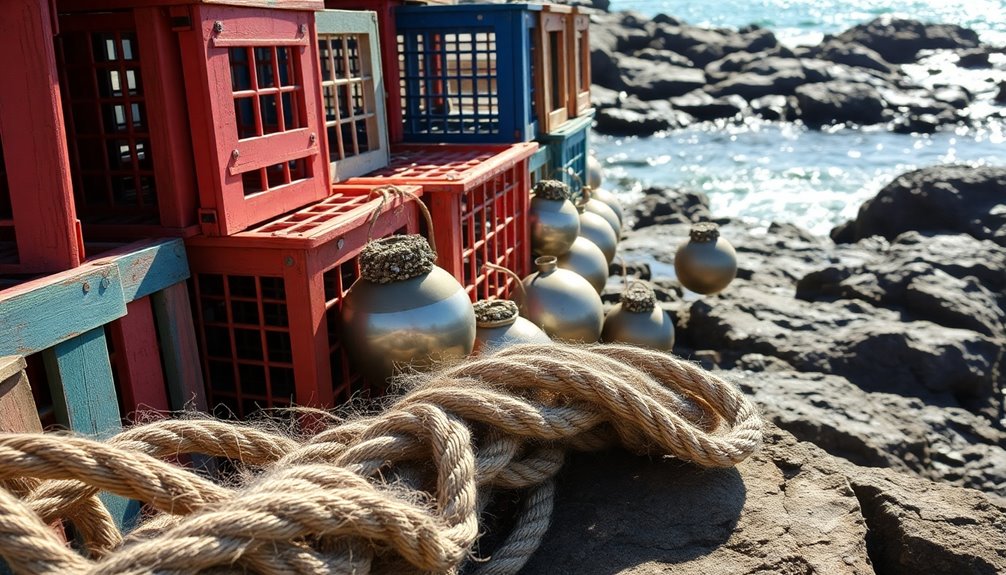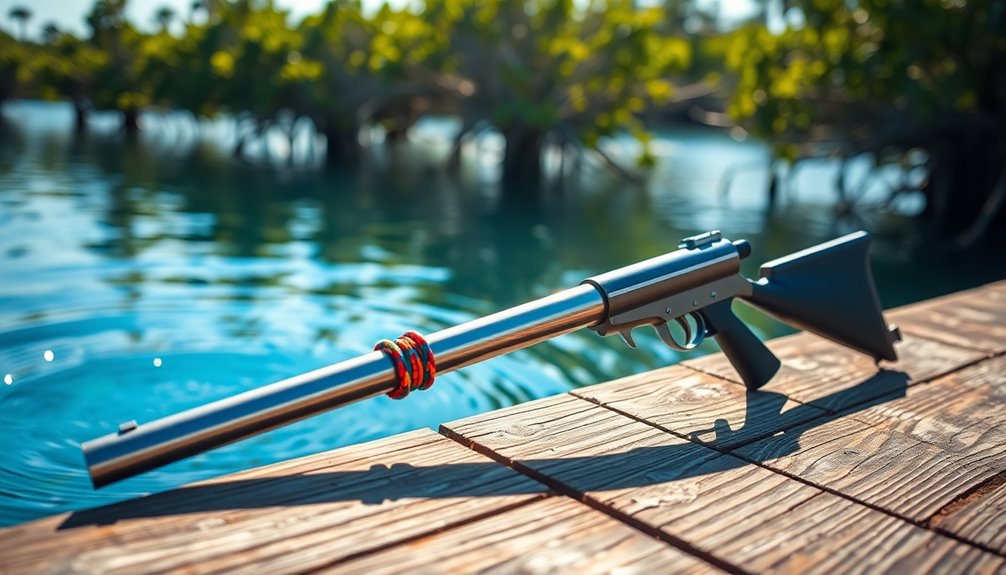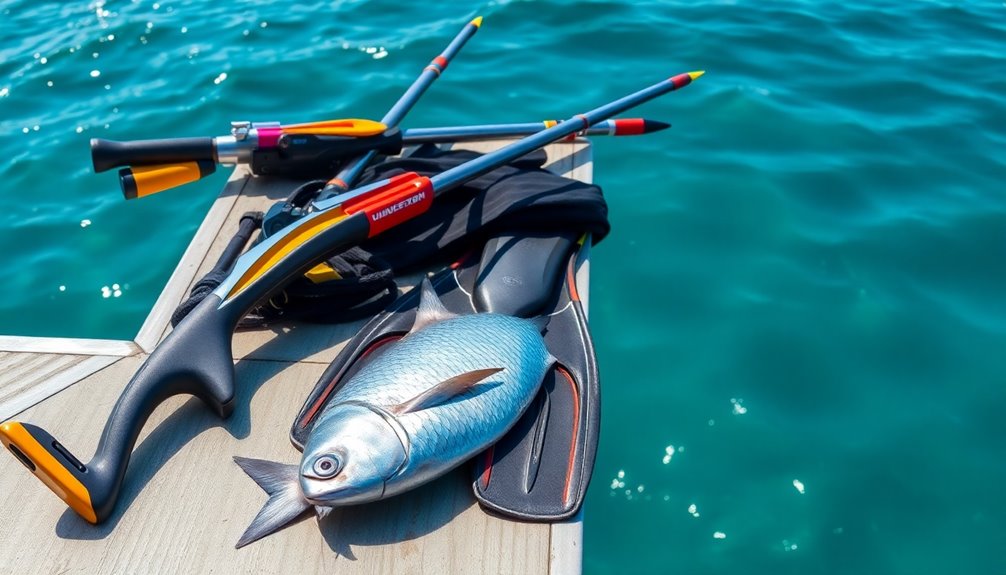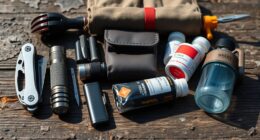A scuba diving weight belt is your essential tool for achieving perfect trim and soaring through the sea! It helps you glide effortlessly by distributing weight properly, so you can move with ease. Different types of belts, like nylon or rubber, suit various diving styles. Choosing the right buckle and weight is crucial for safety and comfort. Correct weighting lets you enjoy a smooth dive and prevents issues like rapid sinking. Remember to adjust your weights and check your gear before each dive. There's so much more to discover about weight belts and diving techniques, so keep exploring!
Key Takeaways
- Choose the right weight belt type, such as a nylon or rubber belt, to ensure comfort and effectiveness during dives.
- Proper weight selection is crucial; consider body type, suit thickness, and water density for optimal buoyancy.
- Distribute weights evenly on your hips and use trim pockets to maintain balance and achieve the perfect trim underwater.
- Regularly practice emergency release mechanisms to ensure quick adjustments during unexpected situations while diving.
- Maintain your weight belt by rinsing it after each dive and inspecting for wear to ensure longevity and reliability.
Understanding Weight Belt Types
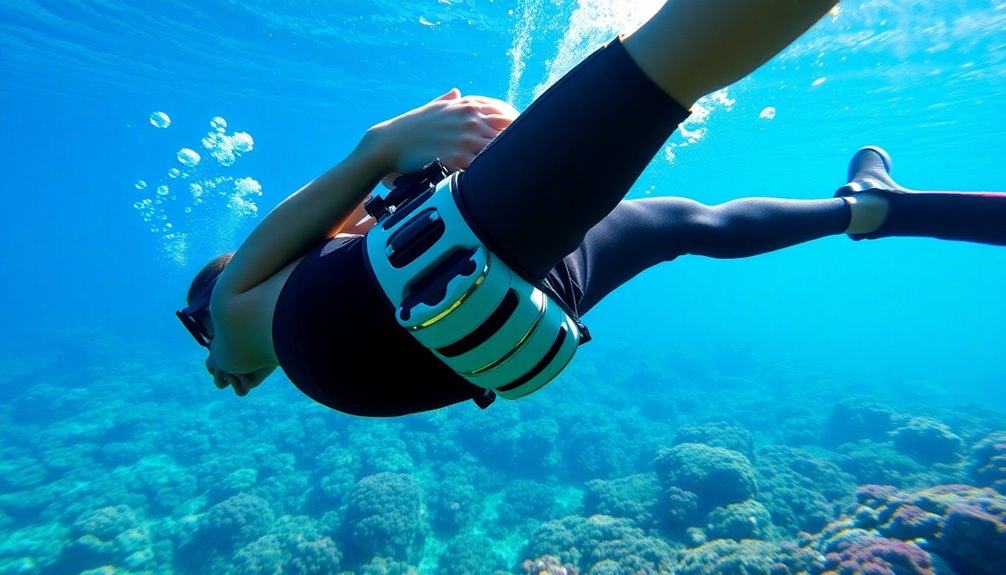
Understanding the various weight belt types is crucial for optimizing your scuba diving experience. Choosing the right belt can make your underwater adventure much more enjoyable! You've got several options to consider.
First up is the nylon weight belt. It's tough, rot-proof, and waterproof, making it popular for rental gear. Proper weighing is essential for effective diving; it ensures that your vertical position on the surface has water halfway up the mask.
If you're into freediving or spearfishing, you might like the rubber weight belt, which keeps weights securely in place.
For experienced divers, the Marseille weight belt feels like a regular belt but can be tricky to release.
Another fun option is the pocket weight belt. This one has pockets for weights, making it comfy and easy to adjust.
If you're looking for something simple, the webbing belt is inexpensive and lasts a long time, though it may slip a bit.
Each type has its unique features, so think about what you need!
Choosing the Right Buckle
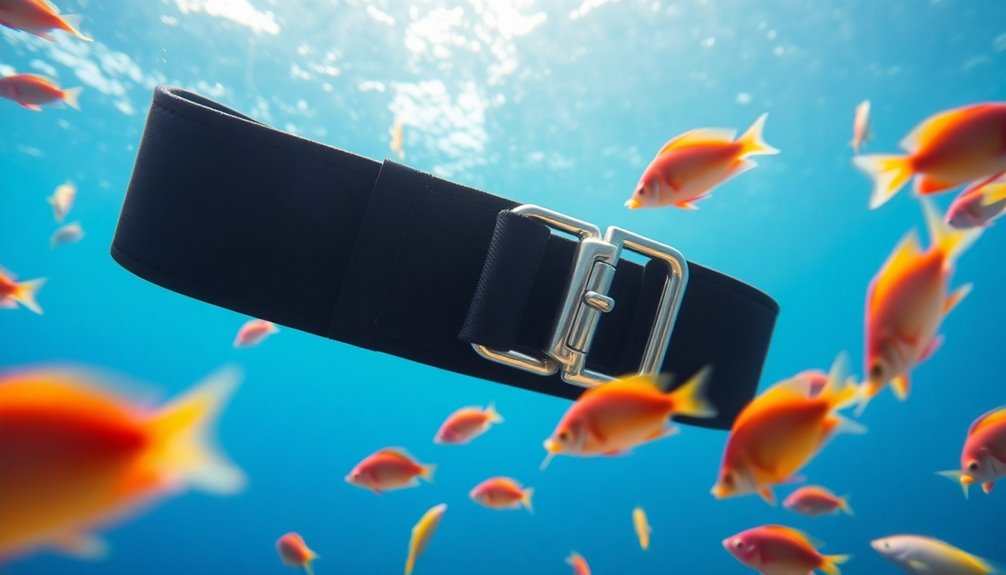
Choosing the right buckle for your scuba diving weight belt is essential for both safety and comfort. You've got a few options to consider!
First up, think about materials. Stainless steel is the best choice. It's super durable and can handle the tough marine environment. Plastic might seem lighter, but it can wear out quickly and even open by itself! Aluminium is another option, but it's delicate and can bend easily with use. Additionally, opting for stainless steel buckles ensures maximum durability and stability in underwater conditions.
Next, let's look at buckle designs. Quick-release buckles are great for emergencies, but they might come undone when you don't want them to. The Marseillaise buckle is more reliable. It works like a regular belt, so it stays secure while allowing adjustments through holes.
Don't forget about fit! Make sure your buckle matches the 50 mm (2 inch) webbing of your weight belt. It should adjust easily for a snug, comfy fit.
Selecting the Best Weights
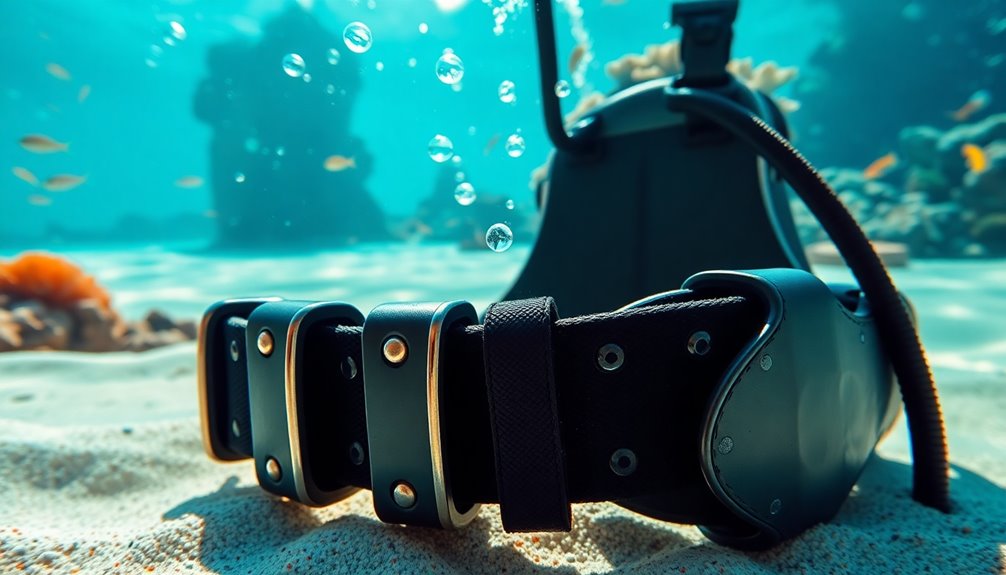
The right weights can make all the difference in your scuba diving experience, enhancing both comfort and safety underwater.
First, consider your own weight and body type. Your BMI is important, too!
Next, think about the water you'll be diving in. Saltwater is denser than freshwater, so you'll need more weight. This is crucial because adjusting weight based on water type helps ensure proper buoyancy.
Don't forget about your diving suit! A thick wetsuit or dry suit requires extra weights to help you sink.
The type of tank you use matters, too. Aluminum tanks float, while steel tanks can help you stay down.
When picking a weight belt, you've got options! Nylon belts are tough and commonly used, while rubber belts keep weights in place during freediving.
If you want comfort, a pocket weight belt allows for easy adjustments.
Importance of Proper Weighting

Proper weighting is crucial for a safe and enjoyable scuba diving experience. When you're weighted correctly, you can glide smoothly through the water, but if you're over-weighted, it can lead to serious problems. Imagine sinking too quickly during a safety stop—it's scary! You need to be able to float up safely, and that's why it's essential to find the right balance.
On the flip side, being under-weighted isn't good either. It makes descending tricky, especially with an empty tank. You might miss vital safety stops, which increases the chance of getting decompression sickness. That's no fun!
Remember, neutral buoyancy is your best friend. It lets you control your movement, conserve energy, and have a blast exploring underwater. Achieving neutral buoyancy is essential for safe and controlled ascents and descents during dives.
Several factors affect how much weight you need, like the type of wetsuit you wear, the water you dive in, and even your body type.
Techniques for Achieving Trim

Achieving trim while scuba diving is all about balancing your body position and weight distribution effectively. When you dive, try to keep your body horizontal. This reduces drag and helps you swim more efficiently. You want your shoulders to be slightly higher than your fins, especially when navigating over obstacles.
If you adjust your trim to match your direction of travel, you'll use less energy and stay stable. Distributing your weight is key too. Make sure your center of gravity aligns with your center of buoyancy. Using trim pockets or attaching weights to your backplate can help you find that perfect balance. The position of your buoyancy center significantly influences your trim stability, making it essential to consider during your dive.
If you notice your legs sinking, ankle weights can help, but they might make it harder to swim fast. Don't forget about your buoyancy compensator (BCD). Inflating it at the surface can change your trim, so be ready to adjust.
Practicing trim checks, like the "Buddha Hover", helps you see where you might need to tweak things. Work with an instructor to discover the best weight distribution for your gear. With these techniques, you'll glide effortlessly through the water, enjoying your dive like never before!
Weight Placement Strategies
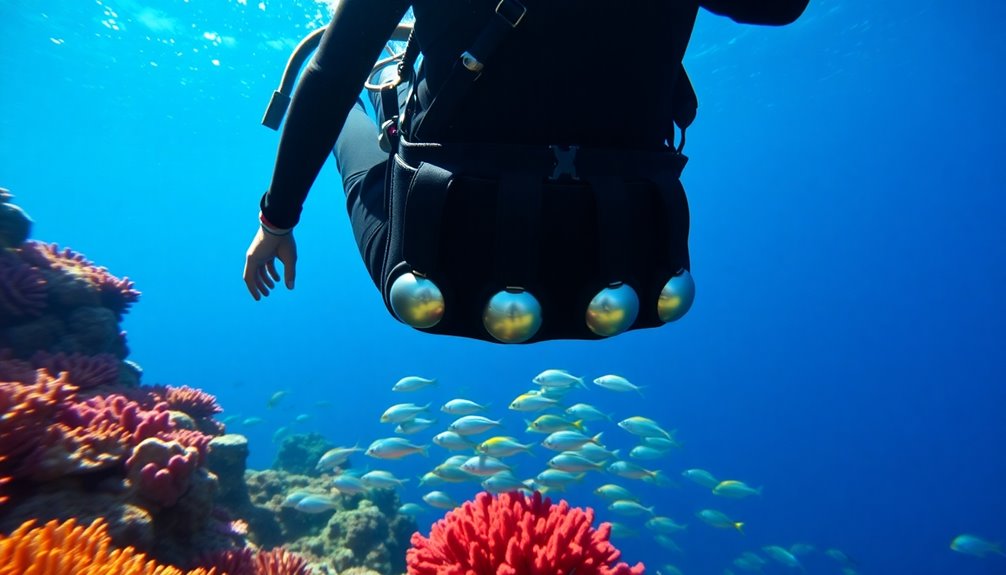
Finding the right weight placement can significantly enhance your trim and overall diving experience. First, think about where you put the weights. Placing them around the front of your hips helps pull your body into the correct position. If you carry a lot of weight, you might want to add trim pockets at the back to keep your balance just right.
Make sure your weights sit on the outside of the belt, away from you. This keeps them stable and prevents movement while you dive. You can also use weight keepers or kink your weight belt for extra security. With the ideal positioning, you'll be able to hover effortlessly in the water, enjoying the sea like never before. Proper weighting ensures that you achieve neutral buoyancy at the end of your dive, enhancing your overall comfort and control.
If you're using different gear, adjust your weight placement accordingly. For sidemount or twin-set configurations, consider placing weight lower to offset the gear's buoyancy.
Remember, the right amount of weight varies based on your wetsuit thickness and tank buoyancy. Proper weight distribution not only improves your trim but also helps you move more efficiently through the water.
Adjustability for Comfort

Comfort is crucial when it comes to scuba diving, especially regarding your weight belt. A well-adjusted weight belt helps you soar through the sea with ease.
Different types of belts offer various levels of adjustability. For instance, nylon belts are popular because they last long and are affordable, but they might slip a bit if not secured correctly.
On the other hand, rubber weight belts hug your body closely, adjusting nicely with your wetsuit for a snug fit.
If you prefer a more tailored experience, pocket weight belts let you easily add or remove weights, spreading the load evenly. This makes your dive much more comfortable! Additionally, accurate knowledge of weight specifications is essential for selecting the appropriate weight belt that matches your diving activity and conditions.
You can also explore lace-through weights, which stay in place and come in different sizes for easier adjusting.
Emergency Release Mechanisms
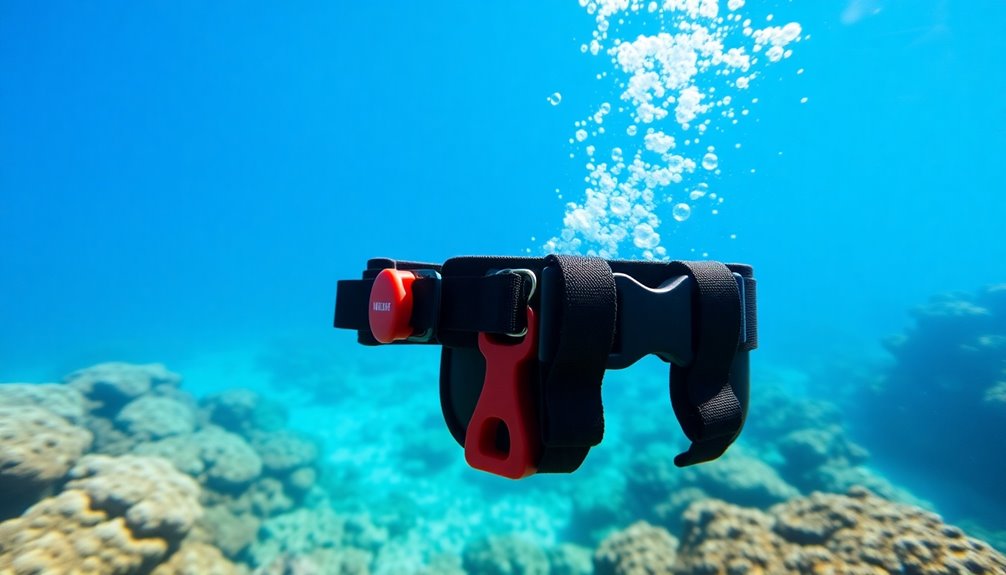
When diving, having an effective emergency release mechanism on your weight belt is essential for your safety. This feature lets you quickly drop weight, allowing you to float up to the surface in case of an emergency.
Imagine you're underwater, and something goes wrong. You want to be able to react fast and not panic! A good release mechanism can help you safely ascend without risking injury. Properly managing your buoyancy with changing gas volume is crucial for a safe ascent, which emphasizes the importance of this mechanism.
You'll find these mechanisms built into weight belts or your buoyancy control device (BCD). They're designed to be easy to reach, even when you're feeling stressed.
Usually, it's a buckle or lever that you can pull quickly. It's important to practice using it regularly so you know exactly what to do if you ever need it.
Before you pull that release, make sure you're at the surface or in deep water where you can't stand. Always be aware of your surroundings during your ascent to avoid any accidents.
Common Mistakes to Avoid
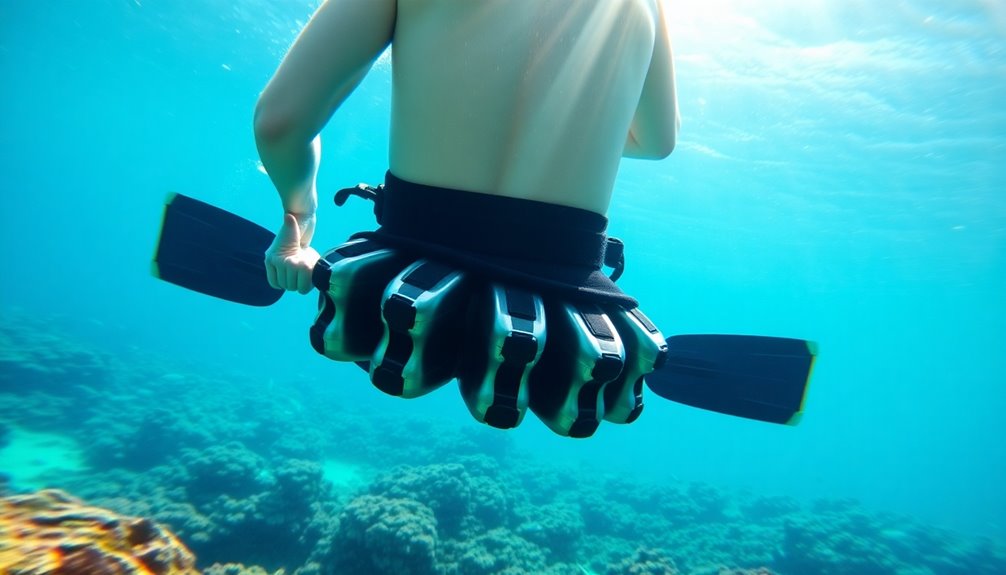
Avoiding common mistakes with your scuba diving weight belt can significantly enhance your safety and comfort underwater. One big mistake is incorrect weight distribution. If you concentrate too much weight in the back, your belt might slide or even rotate, making your dive uncomfortable. Instead, spread the weight evenly around your hips to keep everything in place. Additionally, ensuring proper weight distribution can help prevent head-down or feet-sinking positions during your dive.
Another mistake is overweighting. If you add too much lead, you'll have to inflate your BCD more, which can make you tired and use up air faster. This can lead to an awkward dive position and make swimming harder.
Don't forget to do proper buoyancy checks! Skipping this step could mean you're using more weight than you really need. Remember to adjust your weight based on your gear, like whether your tank is full or empty.
Finally, make sure to adjust your weight belt during the dive. If it loosens, it could come off! Keep it snug, and don't rely on your BCD to hold extra weight.
Maintaining Your Weight Belt

To ensure your scuba diving weight belt remains in top condition, it's essential to incorporate a regular maintenance routine into your diving practices.
After each dive, rinse your weight belt with fresh water to remove salt and debris. This simple step helps prevent damage and keeps your gear in great shape.
Next, inspect the belt for any signs of wear, like fraying webbing or damaged buckles. If you spot any issues, replace those parts quickly to stay safe during your dives. Regularly assess the belt's condition to ensure it meets safety protocol standards.
Store your belt in a cool, dry place, away from direct sunlight, to prolong its lifespan. And remember, avoid leaving weights on the belt when it's not in use to prevent unnecessary stress on the material.
Don't forget about the weights themselves! Regularly check that they're securely attached and free from defects. Make sure they're evenly distributed on the belt for comfort and stability.
Lastly, check that the quick-release mechanism works properly. By following these simple maintenance tips, you'll ensure your weight belt stays reliable, letting you focus on the joy of exploring the underwater world!
Happy diving!
Frequently Asked Questions
How Do I Clean My Weight Belt After Each Dive?
After each dive, you should clean your weight belt to keep it in great shape!
First, soak it in fresh water to wash away the salt. If you have Salt Away, that's awesome for tough salt stains!
Don't forget to rinse the weights separately using a soft brush for any rust spots.
Finally, dry everything completely before storing it in a cool, dry place.
This way, your gear stays ready for your next adventure!
Can I Use a Weight Belt With a Drysuit?
Yes, you can definitely use a weight belt with a dry suit!
In fact, you’ll need a little extra weight compared to wetsuit diving. This helps you achieve the right buoyancy. You’ll want to invest in a high-quality drysuit that will provide insulation while also being comfortable to move in. Look for a drysuit that offers lightweight warmth for extended ocean dives. This will ensure that you stay warm and comfortable underwater for longer periods of time.
Make sure your weight belt is snug but comfortable, so it doesn't slip. You might even want to try a weight vest for better trim.
Just remember to balance your weights for a smooth and enjoyable dive.
Happy diving!
What Is the Lifespan of a Weight Belt?
The lifespan of a weight belt really depends on how often you use it. If you dive regularly, it might wear out faster due to saltwater and pressure.
Webbing belts can slip, while nylon ones last longer.
To keep your belt in good shape, rinse it with fresh water after dives, check for any damage, and store it carefully.
With proper care, you can enjoy your weight belt for many adventures!
How Do I Know if My Weight Belt Fits Properly?
To know if your weight belt fits properly, it should sit snugly around your waist without moving. When you pull on it, it shouldn't slide up or down.
You'll want to feel balanced in the water, so check how it affects your buoyancy. If you float too high or sink too quickly, it might need adjusting.
Are Weight Belts Suitable for Snorkeling as Well?
Yes, weight belts can be great for snorkeling, especially if you want to dive down a bit.
They help you stay underwater longer without using too much energy. You'll get to explore and see cool things up close!
Just remember, they aren't needed for floating at the surface. Choose the right weight for your body, and always prioritize safety.
Don't forget to have fun while discovering the underwater world!
Conclusion
Now that you know all about weight belts, you're ready to dive in and explore the underwater world with confidence! Remember, choosing the right belt and weights is key to achieving perfect trim. You'll glide smoothly through the sea, enjoying every moment. Always check your gear, stay comfortable, and practice safety first. So, grab your gear, take a deep breath, and get ready for an incredible adventure beneath the waves. Happy diving!


